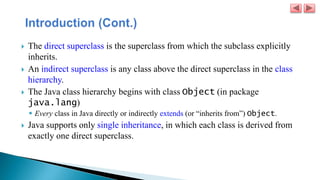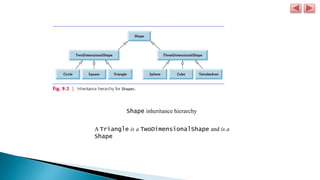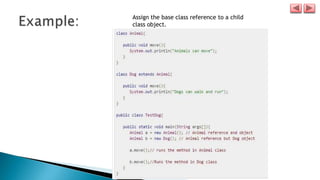Inheritance in java
- 1. Prepared by: Sharifullah “Durrani” Comsats institute of information Technology Abbottabad Pakistan © Copyright 1992-2012 by Pearson Education, Inc. All Rights Reserved.
- 3. Inheritance A form of software reuse in which a new class is created by absorbing an existing class’s members and embellishing them with new or modified capabilities. Can save time during program development by basing new classes on existing proven and debugged high-quality software. Increases the likelihood that a system will be implemented and maintained effectively.
- 4. 4 Inheritance allows a software developer to derive a new class from an existing one The existing class is called the parent class, or superclass, or base class The derived class is called the child class or subclass. As the name implies, the child inherits characteristics of the parent That is, the child class inherits the methods and data defined for the parent class
- 5. When creating a class, rather than declaring completely new members, you can designate that the new class should inherit the members of an existing class. Existing class is the superclass New class is the subclass Each subclass can be a superclass of future subclasses. A subclass can add its own fields and methods. A subclass is more specific than its superclass and represents a more specialized group of objects. inheritance is sometimes referred to as specialization.
- 6. 6 Inheritance relationships often are shown graphically in a UML class diagram, with an arrow with an open arrowhead pointing to the parent class Inheritance should create an is-a relationship, meaning the child is a more specific version of the parent Vehicle Car
- 7. 7 In Java, we use the reserved word extends to establish an inheritance relationship class Car extends Vehicle { // class contents }
- 8. 8 Visibility modifiers determine which class members are inherited and which are not Variables and methods declared with public visibility are inherited; those with private visibility are not But public variables violate the principle of encapsulation There is a third visibility modifier that helps in inheritance situations: protected
- 9. 9 The protected modifier allows a member of a base class to be inherited into a child Protected visibility provides more encapsulation than public visibility does However, protected visibility is not as tightly encapsulated as private visibility Protected variables and methods can be shown with a # symbol preceding them in UML diagrams
- 10. 10 Constructors are not inherited, even though they have public visibility Yet we often want to use the parent's constructor to set up the "parent's part" of the object The super reference can be used to refer to the parent class, and often is used to invoke the parent's constructor
- 11. A child’s constructor is responsible for calling the parent’s constructor The first line of a child’s constructor should use the super reference to call the parent’s constructor The super reference can also be used to reference other variables and methods defined in the parent’s class
- 12. The direct superclass is the superclass from which the subclass explicitly inherits. An indirect superclass is any class above the direct superclass in the class hierarchy. The Java class hierarchy begins with class Object (in package java.lang) Every class in Java directly or indirectly extends (or “inherits from”) Object. Java supports only single inheritance, in which each class is derived from exactly one direct superclass.
- 13. We distinguish between the is-a relationship and the has-a relationship Is-a represents inheritance In an is-a relationship, an object of a subclass can also be treated as an object of its superclass Has-a represents composition In a has-a relationship, an object contains as members references to other objects
- 14. Examples of superclasses and subclasses Superclasses tend to be “more general” and subclasses “more specific.” Because every subclass object is an object of its superclass, and one superclass can have many subclasses, The set of objects represented by a superclass is typically larger than the set of objects represented by any of its subclasses.
- 16. A superclass exists in a hierarchical relationship with its subclasses. Each arrow in the hierarchy represents an is-a relationship. an Employee is a CommunityMember” “a Teacher is a Faculty member.” Superclasses and Subclasses
- 17. Shape inheritance hierarchy A Triangle is a TwoDimensionalShape and is a Shape
- 18. Not every class relationship is an inheritance relationship. Has-a relationship Create classes by composition of existing classes. Example: Given the classes Employee, BirthDate and TelephoneNumber, it’s improper to say that an Employee is a BirthDate or that an Employee is a TelephoneNumber. However, an Employee has a BirthDate, and an Employee has a TelephoneNumber.
- 19. Objects of all classes that extend a common superclass can be treated as objects of that superclass. Commonality expressed in the members of the superclass. Inheritance issue A subclass can inherit methods that it does not need or should not have. Even when a superclass method is appropriate for a subclass, that subclass often needs a customized version of the method. The subclass can override (redefine) the superclass method with an appropriate implementation.
- 20. A class’s public members are accessible wherever the program has a reference to an object of that class or one of its subclasses. A class’s private members are accessible only within the class itself. protected access is an intermediate level of access between public and private. A superclass’s protected members can be accessed by members of that superclass, by members of its subclasses and by members of other classes in the same package protected members also have package access. All public and protected superclass members retain their original access modifier when they become members of the subclass.
- 21. A superclass’s private members are hidden in its subclasses They can be accessed only through the public or protected methods inherited from the superclass Subclass methods can refer to public and protected members inherited from the superclass simply by using the member names. When a subclass method overrides an inherited superclass method, the superclass method can be accessed from the subclass by preceding the superclass method name with keyword super and a dot (.) separator.
- 22. Java supports single inheritance, meaning that a derived class can have only one parent class Multiple inheritance allows a class to be derived from two or more classes, inheriting the members of all parents Collisions, such as the same variable name in two parents, have to be resolved Java does not support multiple inheritance In most cases, the use of interfaces gives us aspects of multiple inheritance without the overhead
- 24. 24 A child class can override the definition of an inherited method in favor of its own The new method must have the same signature as the parent's method, but can have a different body The type of the object executing the method determines which version of the method is invoked
- 25. A parent method can be invoked explicitly using the super reference If a method is declared with the final modifier, it cannot be overridden The concept of overriding can be applied to data and is called shadowing variables Shadowing variables should be avoided because it tends to cause unnecessarily confusing code
- 26. 26 Don't confuse the concepts of overloading and overriding Overloading deals with multiple methods with the same name in the same class, but with different signatures Overriding deals with two methods, one in a parent class and one in a child class, that have the same signature Overloading lets you define a similar operation in different ways for different data Overriding lets you define a similar operation in different ways for different object types
- 28. Assign the base class reference to a child class object.
- 30. the object can call the overriding methods of child class and all the non-overridden methods of base class but it cannot call the methods which are newly declared in the child class
- 31. Argument list: The argument list of overriding method must be same as that of the method in parent class. The data types of the arguments and their sequence should be maintained as it is in the overriding method. Access Modifier: The Access Modifier of the overriding method (method of subclass) cannot be more restrictive than the overridden method of parent class.
- 32. This is not allowed as child class disp method is more restrictive(protect ed) than base class(public)
- 33. Its valid
- 34. private, static and final methods cannot be overridden as they are local to the class. However static methods can be re-declared in the sub class. Binding of overridden methods happen at runtime which is known as dynamic binding. super keyword is used for calling the parent class method/constructor.
- 35. super keyword is used for calling the parent class method/constr uctor.
- 36. 36 A class called Object is defined in the java.lang package of the Java standard class library All classes are derived from the Object class If a class is not explicitly defined to be the child of an existing class, it is assumed to be the child of the Object class Therefore, the Object class is the ultimate root of all class hierarchies
- 37. The Object class contains a few useful methods, which are inherited by all classes For example, the toString method is defined in the Object class Every time we have defined toString, we have actually been overriding an existing definition The toString method in the Object class is defined to return a string that contains the name of the object’s class together along with some other information
- 38. All objects are guaranteed to have a toString method via inheritance Thus the println method can call toString for any object that is passed to it






































